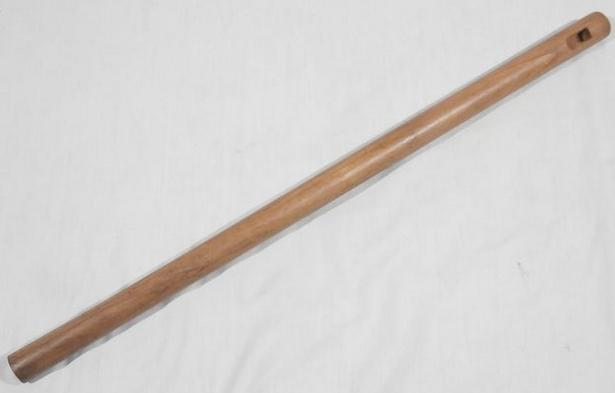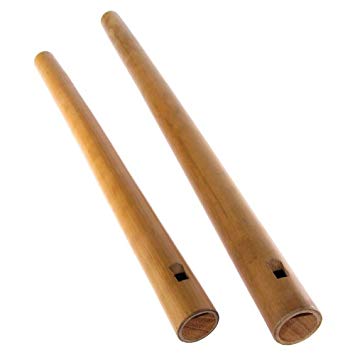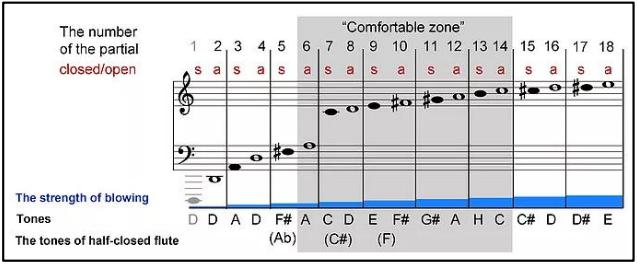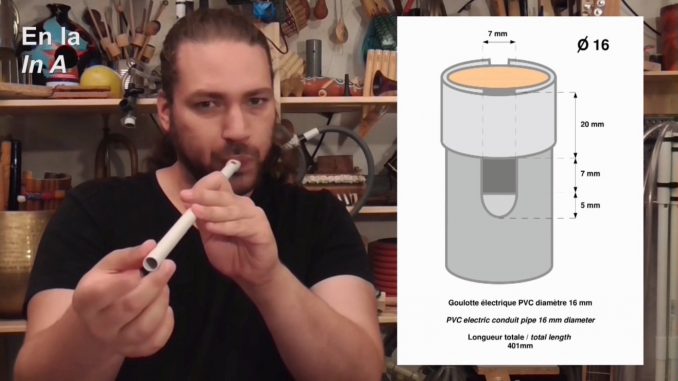by Howard Fosdick © FolkFluteWorld.com.
Any flute player -- and indeed, any musician -- would benefit from knowing a bit about the overtone flute.
The overtone flute is the most primitive musical instrument you can imagine. It's nothing more than a hollow wood tube.
At one end is a hole into which you blow. Most often it's a fipple that looks like a simple slit, similar to that of a primitive recorder. Or it might be a round hole similar to that of the transverse flute. The slit-fipple design is easier to play and is more common.
Flutes with fipples extend straight out from the musician when played. Those with round holes, such as Scandinavian versions, are played transverse.


Playing the Overtone Flute (Photos courtesy of Shemyaz at Youtube and OvertoneFlute.fi)
What's unique about the overtone flute is that it does not have any fingering holes! It's simply a flush hollow tube. You create sounds by blowing: how hard you blow determines the pitch the instrument plays. Blow harder and you'll attain the next note higher in the flute's harmonic series.
The frequency of each higher pitch is an integer multiple of the lowest pitch the instrument plays. Some call this the "natural scale." It's defined by the physics of how sound waves resonate within a tube of fixed length.
For example, a 5' long flute with a base pitch of 110 Hz could voice these notes. Notice the linear increase in frequency:
| Frequency | Note |
|---|---|
| 110 Hz | A2 |
| 220 Hz | A3 |
| 330 Hz | E4 |
| 440 Hz | A4 |
| 550 Hz | C#5 |
| 660 Hz | E5 |
| 770 Hz | G5 (apx.) |
| 880 Hz | A5 |
| 990 Hz | B5 |
Most musicians are familiar with the concept of increasing breath pressure to raise pitch and play higher notes. For example, tin whistle players overblow their instrument to attain notes in the higher octave. What makes the overtone flute unique is that it depends exclusively on this principle.
With the overtone flute, you can get an additional, second scale of harmonics by covering the end of the tube with your finger. This is another complete scale with notes that sound slightly higher than their open-ended equivalents. Integrating the closed- and open- ended scales together give you the overtone flute's full set of playable notes.
How They Sound
So how do these primitive flutes sound?
Sound varies by the pitch of the instrument, its dimensions, composition, and the musician's skill. Here are a few samples:
- Winne Clement of Belgium demonstrates the flute in a tutorial
- This Ukrainian trio features an overtone flute leading two ocarinas
- Here's an excellent tutorial with sound samples by maker Max Brumberg
of Germany


Overtone Flutes (Photos courtesy of HungarianFolkMusic @Etsy and Amazon)
Origins and Traditions
As you might guess from their primitive nature, overtone flutes stretch back into antiquity. They're the ancient ancestor of the flutes we play today.
Overtone flutes have been obsoleted by all manner of modern flutes: concert flutes, piccolos, recorders, tin whistles, and Irish flutes, to name a few. Even primitive three-hole flutes dating from the middle ages -- like the tabor pipe -- are more technologically advanced than the simple overtone flute.
Yet this distant ancestor to modern flutes survives as part of the cultures of many peoples. For example, in Russia and the Ukraine, the kalyuka was traditionally made from the hollow plant stems cut during harvest. These were readily available and fun to play, but they weren't very durable.
The koncovka of Slovakia comes complete with cut fipple. As does the tilinkó from Hungary. Other eastern and central European nations with overtone flute traditions include Romania, Moldavia, Poland, Germany, and the Baltic republics.

Koncovka from Slovakia (Courtesy of Michal Matúšov as posted at Wikipedia)
In Scandinavia, they call it the willow flute. Farmers would fashion instruments from green willow branches in spring. By fall, they would dry out and become unplayable. Each Scandinavian language has its own term for this traditional flute. It's usually played transverse.
How to Play
Learning to play this primitive instrument differs from how one approaches modern concert instruments. There are no teachers and no sheet music.
Instead, rely on Youtube tutorials and the tutorials and lessons you'll find at the websites of the overtone flute makers. Here's a link to Youtube videos.
I found it easy to get started with the willow flute -- though I found it difficult to attain proficiency. To start, learn to play the different harmonics and memorize the breath pressure required for each note. Pay attention, too, to the approach or attack appropriate to each tone. This varies by pitch.
Then expand into the notes you can play by covering the end of the flute with your finger. You can use either your index finger or long middle finger to cover the flute's end, depending on how you cradle it.
Eventually, you'll develop a memory for the breath pressure and approach that enables you to quickly sound any note. Now you're ready to invent tunes.
Songs are usually improvised. So if you enjoy improvising, the overtone flute might be the perfect instrument for you. It's well suited given that its notes are natural harmonics.
On the other hand, if you favor the formality of sheet music or prefer direction, you might not take to the instrument as readily.
Once you acquire some skill, you'll find this simple flute capable of a wide range of musical expression. For example, you can trill either by rapid tongue movement, or by quickly waving your finger over the end of the tube. Create fades and slides by varying breath pressure, or by carefully moving your finger over the pipe end. Pop up notes in the natural scale by attacking with your breath. Drop down the scale by letting your breath blow out. Delicate vibrato enhances long notes. Exaggerated vibrato creates its own special effect.
Range
The tonal range of an overtone flute depends on two factors: the physical construct of the flute and the skill of its player.
This chart shows the notes played by a D-tuned Finnish overtone flute. It gives you an idea of the instrument's range. It helpfully distinguishes the notes that are practical and useful versus those that are out of most players' comfort zone:

(Chart courtesy of maker Janne Ojajärvi of OvertoneFlute.fi)
Here are the notes played by a Slovak koncovka made in the key of G. As per typical notation, notes produced by closing the pipe are filled in:

(Chart courtesy of WikiVisually)
This chart shows scales typically playable by overtone flutes depending on their key (or base note). These are flutes made by the company, Hungarian Folk Music, who sell their wares on Etsy and Ebay:

A few overtone flutes feature a single hole near the end of the instrument, called the half-tone hole. This extends the instrument's capabilities. It gives you access to a half-tone scale and facilitates playing in minor keys. Simply grip the instrument such that you can use your thumb to cover and uncover the half-tone hole.
You can also change pitches by skillfully covering just a portion of the end of the pipe with your finger. (This is just like half-holing a finger hole on a recorder, ocarina, or tin whistle.) This technique requires some practice but can be very effective.
Where to Buy
Most overtone flutes are handmade by individuals or crafted at small companies. Almost any kind of wood can be used, though elder, willow, birch, and bamboo are most common. Woods may be finished or unfinished, depending on your preference. A simple slit fipple is the most popular mouthpiece.
Prices vary by the maker. Most cost between $30 and $100.
Key factors you'll want to consider when buying a flute include its:- Kind of blow-hole (slit or fipple)
- Key (its lowest note or base note)
- Whether it's end-blown or played transverse
- Type of wood or composition
- Finish (or the lack thereof)
- Appearance
- Sound
- Ratio of bore diameter to length
- Whether the flute has a half-tone hole
- Price
| Winne Clement (Belgium) | Max Brumberg (Germany) |
| Dan Moi (Germany) | Hungarian Folk Music (Hungary) |
| Fujara Flutes (Slovakia) | Jakub Šaray (Slovakia) |
| Kaypacha (Argentina) | Nadishana (Siberia) |
| Janne Ojajärvi (Finland) | Lark In the Morning (USA) |
| Kirsi Vinkki (Finland) | Sound Travels (UK) |
Make Your Own
Instead of buying, you might craft your own flute.
It's much easier to make an overtone flute than any other kind of flute. You don't have to drill fingering holes. The slit fipple is simple and primitive compared to removable mouthpieces. And, you won't need to fashion interconnecting joints because overtone flutes consist of but a single tube.
Almost any kind of wood will do, though some woods sound better (and are easier to work), than others. Traditional choices include elder, willow, birch, and bamboo.
To succeed, you'll need to have a good auger or spade bit, and you must be able to drill a long, straight bore.
An alternative to wood is to create your overtone flute from PVC pipe. PVC is a hard plastic widely available at hardware stores and from sellers of construction materials. The advantage to PVC is that you don't have to bore a straight hole through a longitudinal pipe. This makes it much easier to build your instrument.

Making a PVC Overtone Flute (Courtesy of Musiquesdenullepart on Youtube)
Some people prefer a precision-made instrument composed of high-quality plastic. They like its modernity, its symmetric lines and durability. Others prefer the warmer sound of wood and its more natural look. Go for whatever fits your personal preference.
You can find several videos showing how to make your own overtone flute from either wood or PVC at Youtube. There are also instructions at various websites including overviews at several maker sites.
New Possibilities
Understanding how the overtone flute works is useful to any flute player.
Should you try one, you'll find it opens up a whole new musical world. You can experiment with the natural scale and overblowing, half-holing and the instrument's unique espressivo. This flute is ideal for improvisation. You might even take up the challenge of making your own instrument!
Best of all, you can create some fascinating music.